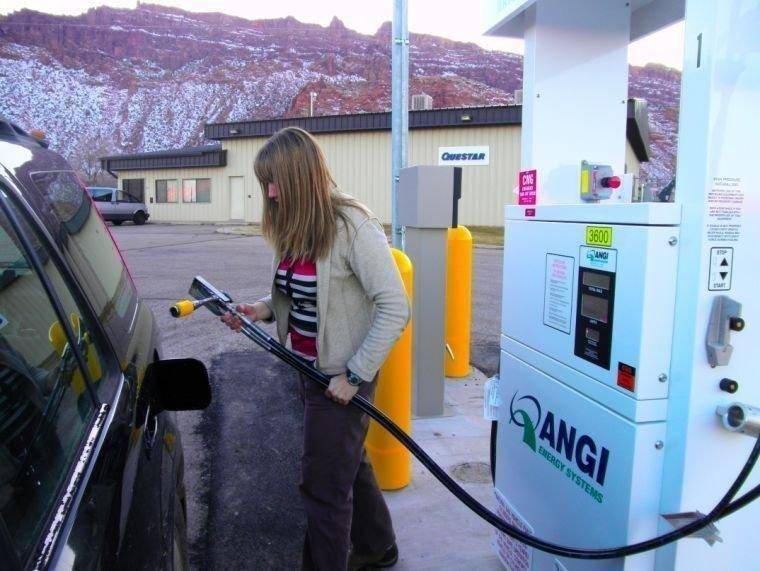В
Moab has joined the ranks of American towns that offer drivers compressed natural gas (CNG) filling stations.
В
Questar opened the areas first CNG fast-fill pump at a company facility just south of town on Hwy. 191. The station is open to the public and Questar is planning an open house event for the station for government agencies, businesses and the community in early March, said Darren Shepherd, a spokesman for the company.
There has been a fair amount of interest in CNG in Grand County for the last several years, because it is both cleaner burning and, at $1.50 per gallon, it is significantly less expensive than gasoline or diesel. However, for the Moab area, CNG development has been a bit of a chicken or the egg problem.
“No one wants to build a station until there are cars for them, but no one wants to adopt CNG into their fleet until there are fill stations in town,” said Verna Butcher, the transportation supervisor for the Grand County school district.
But while many government agencies in town are excited about the new CNG station, there are no current plans for any of them to switch their fleets over.
A big reason that the new fill station was put in Moab is that there have been recent moves by several major heavy-duty trucking companies to begin changing their vehicles over to natural gas. And since so many long-haul trucks come through Moab on Hwy. 191, this fill station will help make the surrounding area accessible to these vehicles, said Robin Erickson, the director of the Utah Clean Cities Coalition, the organization that helped to organize the grant that paid for 70 percent of the new Questar station.
Opening up southeast Utah to CNG vehicles fits into a broader statewide plan initiated under Gov. Jon Huntsman, Jr., for Utah to lead the way in development of natural gas infrastructure.
“Gov. Huntsman’s original plan was to create a natural gas corridor along I-15 so you would never have to go more than 100-miles for a station,” Shepherd said..
The plan has succeeded and now Utah has more natural gas infrastructure for transportation than almost any other state.
There are also currently around 20,000 motorists in Utah (mostly along the Wasatch Front) using natural gas in their cars. Salt Lake City is even providing free parking at all parking meters for low-emissions vehicles, Erickson said.
Along with being cheaper and cleaner than gas or diesel, CNG also appeals to many because it is a domestic source of energy.
“We have the biggest natural gas reserves in the world, but instead of using it we are exporting it then importing more expensive, dirtier oil,” said Herb Jensen, the director of transportation for the Jordan School District, in the southern part of the Salt Lake Valley.
The district started using CNG buses 13 years ago and now has 54 in its fleet.
Though there are CNG cars available to the public that, like Jordan school district’s buses, run on dedicated natural gas engines, many private CNG cars use bi-fuel engines. Bi-fuel engines allow the driver to switch from CNG to gasoline by simply flicking a switch.
These low-emissions vehicles are filled up one of two ways; the first is a fast-fill station (like the new Questar station), which refills a tank at about the same speed as a standard gas pump. The second is primarily used for commercial or government fleets.
Called a time-fill system, it works by attaching a hose to the vehicle, which fills it over night. At between $500,000 and $1 million, both types of stations are quite expensive. And though the fast-fill system is less efficient than the time-fill, both systems give vehicles about the same driving range as a tank of gas, Erickson said.
According to the Utah Clean Cities Coalition figures, there are now 87 public and private CNG stations across the state.
“Moab was critical for us to put a station to serve I-70, since the gas line stops at Salina,” Erickson said. “The closest stations going the other way are in Price and Grand Junction.”
So from Moab, a CNG vehicle could easily make it up to Salt Lake City, either by going along I-70 or up Hwy. 6.
“We have been told by many people coming through town that having a CNG station here would be beneficial, that it would bring more people to Moab,” said Ken Davey, Moab’s administrative analyst and economic development specialist.
But while the town’s first CNG station may already be built, the upfront cost of CNG vehicles is slowing government agencies’ push to trade out their fleets.
“It would be cheaper in the long-run, but there are big start-up costs,” Butcher said. “It’s about $30,000 more per school bus to do CNG.”
Arches National Park also looked into using CNG buses to ferry visitors around the park. But though the idea has already been successful at other national parks, like Zion National Park, Arches currently does not have enough funding.
“Though there is grant money available, we would still have to pay part of the initial cost and the cost of operations,” said Paul Henderson, the assistant superintendent for Canyonlands and Arches national parks.
And though the Bureau of Land Management (BLM) is pushing to make their fleet more efficient by minimizing trips and culling less efficient vehicles, there are no current plans to switch to CNG, said Walter Birkenheier, the assistant district manager for canyon country district.
While government may be slow to adopt CNG, it is possible that private businesses will move ahead with it, Erickson said.
“We know of 11 different businesses in Moab that want to convert to their vehicles to CNG,” she said. “But if we want more stations, we need people to use this station. We built it for the right reasons, now we have got to use it.”
Read more at MOABSUNNEWS.com
В

